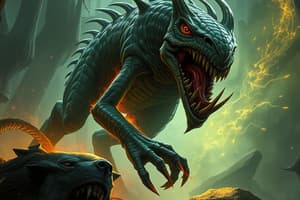Podcast
Questions and Answers
What type of adaptation allows species like octopuses and chameleons to blend into their environment?
What type of adaptation allows species like octopuses and chameleons to blend into their environment?
- Structural defenses
- Chemical defenses
- Crypsis (correct)
- Aposematism
Which structural adaptation is demonstrated by the Crucian Carp when detecting predators?
Which structural adaptation is demonstrated by the Crucian Carp when detecting predators?
- Color pattern alteration
- Hump-shaped body (correct)
- Development of spines
- Increased body length
What is the primary function of the mechanical defenses some species develop?
What is the primary function of the mechanical defenses some species develop?
- Reducing predator capture efficiency (correct)
- Enhancing camouflage
- Increasing nutritional value
- Creating chemical reactions
Aposematism in animals refers to which of the following mechanisms?
Aposematism in animals refers to which of the following mechanisms?
What unique ability do bombadier beetles have that serves as a defense mechanism?
What unique ability do bombadier beetles have that serves as a defense mechanism?
How do some predators avoid toxic prey according to evolutionary adaptations?
How do some predators avoid toxic prey according to evolutionary adaptations?
What happens to water fleas when they detect chemical cues from predators?
What happens to water fleas when they detect chemical cues from predators?
Which of the following is NOT an outcome of herbivory on ecosystems?
Which of the following is NOT an outcome of herbivory on ecosystems?
What kind of adaptations might prey species develop to cope with predation pressure?
What kind of adaptations might prey species develop to cope with predation pressure?
Which of the following statements about chemical defenses is FALSE?
Which of the following statements about chemical defenses is FALSE?
What role did the Myxoma virus play in controlling the rabbit population in Australia?
What role did the Myxoma virus play in controlling the rabbit population in Australia?
Which of the following statements accurately describes counter adaptations in consumer species?
Which of the following statements accurately describes counter adaptations in consumer species?
How does herbivory significantly impact ecosystems?
How does herbivory significantly impact ecosystems?
What is a primary evolutionary response observed in the cactus moth as it interacts with the prickly pear cactus?
What is a primary evolutionary response observed in the cactus moth as it interacts with the prickly pear cactus?
What is an example of a predator adaptation in response to prey defenses?
What is an example of a predator adaptation in response to prey defenses?
Which aspect of bovine digestive systems illustrates adaptation to herbivory?
Which aspect of bovine digestive systems illustrates adaptation to herbivory?
In the context of species interactions, what does 'selective pressure' refer to?
In the context of species interactions, what does 'selective pressure' refer to?
What is an outcome of evolutionary responses in both prey and predator populations during species interactions?
What is an outcome of evolutionary responses in both prey and predator populations during species interactions?
What defines a top predator in an ecosystem?
What defines a top predator in an ecosystem?
In the context of prey defenses, which adaptation involves an organism changing its behavior to avoid detection?
In the context of prey defenses, which adaptation involves an organism changing its behavior to avoid detection?
What is the primary difference between a parasite and a parasitoid?
What is the primary difference between a parasite and a parasitoid?
Which of the following is not a strategy for predators during active hunting?
Which of the following is not a strategy for predators during active hunting?
Which type of defense mechanism involves the prey's appearance resembling inedible objects?
Which type of defense mechanism involves the prey's appearance resembling inedible objects?
What is an example of a behavioral defense among prey species against predators?
What is an example of a behavioral defense among prey species against predators?
Which of the following adaptations does not specifically describe a structural defense against predation?
Which of the following adaptations does not specifically describe a structural defense against predation?
What were tadpoles observed to do in the presence of predator cues during the experiment?
What were tadpoles observed to do in the presence of predator cues during the experiment?
Which mechanism allows prey to blend into their surroundings, reducing predation risks?
Which mechanism allows prey to blend into their surroundings, reducing predation risks?
What key factor influences the evolution of prey defenses against predators?
What key factor influences the evolution of prey defenses against predators?
Flashcards are hidden until you start studying
Study Notes
Species Interactions
- Small carnivores are top predators, consuming herbivores and mesopredators.
- Examples of top predators include wolves, mountain lions, and sharks.
- A parasite consumes part of a resource without killing it, while a parasitoid consumes a part leading to death.
- Detritivores feed on dead organic matter without impacting the species that produced it.
Evolution of Defenses in Animal Species
- Understanding predator hunting strategies is essential for analyzing prey defense evolution.
- Active hunters search continuously for prey, while ambush hunters wait for prey to approach.
Types of Prey Defenses
- Behavioral defenses include alarm calling, spatial avoidance, and reduction of activity.
- Alarm calling alerts relatives to nearby predators, while spatial avoidance involves moving away from predators.
- Prey reduces movements to minimize predator encounters.
Tadpole Behavior Experiment
- An experiment assessed tadpole activity levels with and without dragonfly predators.
- All tadpole species reduced their activity in the presence of a predator.
Crypsis
- Crypsis involves prey adapting their appearance to blend with the environment or mimic inedible objects.
- Examples include species resembling sticks or leaves, aiding in camouflage.
- Some species can rapidly change color, such as octopuses and chameleons.
Structural Defenses
- Mechanical defenses hinder predator capture and attack efficiency.
- Examples include porcupines with quills and water fleas that develop spines in response to chemical predator cues.
- The Crucian carp develops a deeper body shape when detecting predators, enabling better escape.
Chemical Defenses
- Skunks spray foul-smelling chemicals to deter threats.
- Monarch butterfly caterpillars store milkweed toxins, making adult butterflies distasteful to predators.
- Bombardier beetles mix and eject chemicals at high temperatures as a defense.
Aposematism
- Aposematism involves highlighting toxins through warning coloration, making high contrast colors like yellow or red easily recognizable to predators.
- Some predators learn to avoid toxic prey through experience or inherent aversion to bright colors.
Examples of Species Interactions
- Myxoma virus was introduced to control rabbit populations in Australia, resulting in significant mortality rates.
- Surviving rabbits developed resistance to the virus, which exerted selective pressure, leading to less virulent strains of the virus becoming prevalent.
Prickly Pear Cactus and Cactus Moth
- The prickly pear cactus, native to the Americas, became a pest in Australia following its introduction in the 19th century.
- Biologists introduced cactus moths to control the cactus spread effectively.
Studying That Suits You
Use AI to generate personalized quizzes and flashcards to suit your learning preferences.





